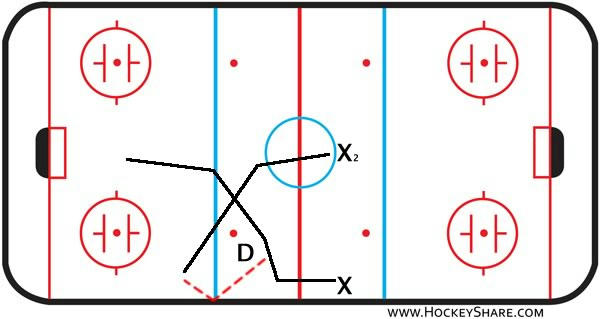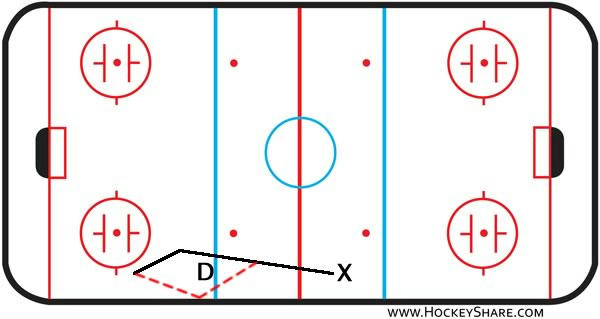Zone Entry – Board Passes
Getting the puck into the zone can be the difference between creating a scoring opportunity and giving one up. Using a simple board pass play can be one of the most efficient means of entering the offensive zone. In this post, we’ll take a look at two different examples of a board pass as well as a video example from an NHL game.
The first scenario has two offensive players attacking up ice with the puck carrier along the wall. As the puck carrier approaches the defenseman, he begins to cut to the middle of the ice. The second forward proceeds to cut behind the defenseman (before the blue line, and being sure not to interfere with the defender’s established lane). The puck carrying forward makes a simple pass off the wall for the second forward to pick up (staying onside).
This tactic creates a couple of different situations to examine. First, by the puck carrier cutting to the middle before the pass, the defender is forced to respect the position of the puck carrier, thus creating more space along the wall for the area the pass will eventually go. While the board pass can still be effective to a teammate without the step the middle, the extra movement often helps create extra space for the recipient of the pass.
Next, by having one forward moving behind the defenseman, the puck carrier moving to the middle, and the puck moving off the boards, this can create a lot of confusion for the defender, as he’s forced to make a decision on what to defend – which also requires communication with his/her defense partner.
If the play is executed cleanly, the original puck carrier should cut to the net and look to create a 2 on 1 against the remaining defender (if any). Below is a diagram of how the play should look.

Another way to enter effectively using a board pass is to actually pass the puck to yourself and side-step the defender. In this scenario, the puck carrier will skate directly at the defenseman, chip the puck off the boards, and go around the opposite side of the player. This will create confusion for the defender, as he’s forced to make a split-second decision on whether to 1) pivot to get the puck 2) pivot to take the player 3) stand his ground. If you get the defending player to pivot, the offensive player has the advantage as there tends to be a loss of speed when players pivot from backwards to forward, while the offensive player can accelerate forward and get around the defender. If the defenseman decides to hold his ground and not let you through, the best option is to keep your feet moving and try to get around him. Many times officials will call an interference penalty since the puck has already left your possession. By the rules, defenders should be allowed to hold their established lane, but cannot continue to impede you after any initial contact.
Below is a diagram of this scenario along with an NHL YouTube clip of the play in use.

httpv://www.youtube.com/watch?v=1a74fecr2mY
When possible, try to incorporate some of these tactics into your practices so players will be comfortable enough to use them in game situations.
